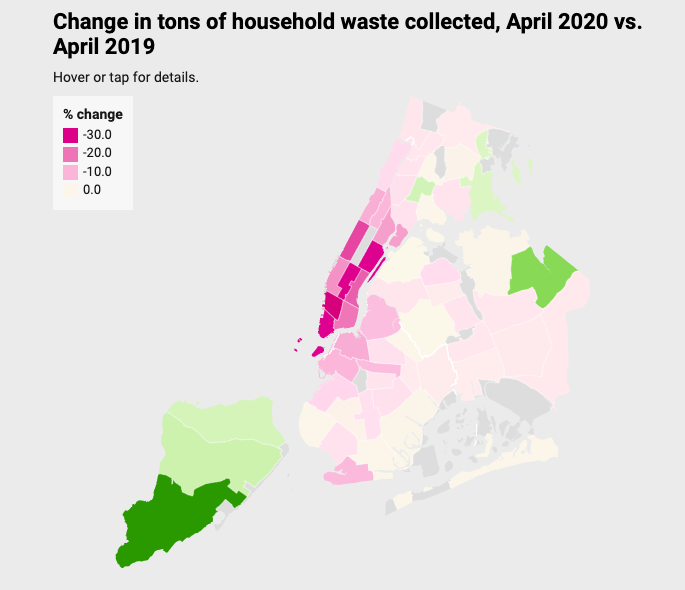Garbage Pickups Dove Deeper In April As New Yorkers Ditched Town Or Dug In

By Gabriel Sandoval and Ann Choi, Originally published in THE CITY.
Household trash pickups by sanitation workers fell across much of the city last month, with a 20% drop in Manhattan for April over the same period last year.
All but a dozen of the city’s 59 community districts saw declines in refuse, recycling and organic waste collected this April versus last — topped by a 32% plunge for Greenwich Village and SoHo.
Brooklyn community districts encompassing neighborhoods that include Brooklyn Heights, Fort Greene, Williamsburg and Park Slope, among others, also showed marked decreases in tons of trash hauled away.
Staten Island was the only borough to see an overall collection increase.
Citywide, trash collections were down 5.7% over last April, as some New Yorkers stocked up on eats and hunkered down, others turned to food banks to piece together meals and still others fled the nation’s coronavirus epicenter. More than 20,000 have died.
The lighter garbage loads marked a further decline since THE CITY reported dwindling collections for March, when coronavirus first slammed New York.
April’s drop is even sharper when measured against the amount of waste collected on average for the month in the previous five years — with a 20% citywide decrease and several Manhattan neighborhoods, including the Upper East Side, seeing a decline topping 40%.
Meanwhile, the Department of Sanitation says it’s still running the same pickup routes, with the same frequency, as before the virus struck.
“We cannot change service based on increases or decreases in tonnage, as we still need to provide service to the same number of residents, relying on the same number of workers operating the same number of trucks making the same number of stops,” said Belinda Mager, a Sanitation spokesperson.
Budget Cuts
Mayor Bill de Blasio’s recent budget, pummeled by the coronavirus crisis, includes modest proposed cuts to Sanitation programs. Notably, organic waste pickup has been suspended as of May 4.
The budget anticipates a modest drop in the number of uniformed sanitation workers for the coming year, from an estimated 7,842 by the end of June down to 7,425 a year later. Those would be reached through attrition, Mager indicated.
To protect New York’s Strongest, said Mager, the department has taken measures that include providing protective gear, additional cleanings of Sanitation facilities and earlier 5 a.m. starts to shifts to promote social distancing.
Some 615 employees have tested positive for the coronavirus, 391 of whom are back on the job, she said.
“We are sorry to share that five employees have passed due to COVID,” Mager added.
Mager cautioned against reading into the plummeting collection numbers as New York City reels from the ripple effects of infections and related economic shutdowns.
“What we throw out says a lot about who we are and what we value as a culture,” she said. “I think we’ll really need some time to sit and review the data before assigning too much meaning to a rise here or a fall there.”




